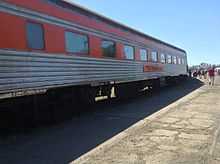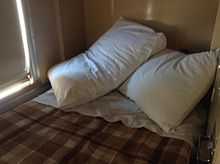Vinelander

The Vinelander was an Australian named passenger train that operated by the Victorian Railways between Melbourne and Mildura from August 1972 until September 1993. Operating overnight along the Mildura line, it included motorail and sleeping car facilities.

History
A trial daylight service, the Mildura Sunlight, commenced between Melbourne and Mildura on 3 September 1957. Air-conditioned Z type carriage stock was used, running thrice weekly.[1]
Night trains replaced this from 1967, and a Motorail service was added in 1968.[2]
The Vinelander first ran on 9 August 1972 after intense local lobbying for an upgrade of the existing overnight train.[3] The name was the product of a naming completion held by the Victorian Railways, with steel sleeping cars formerly used on The Overland being used,[4] along with older wooded stock. A buffet car and bar was added to the train from 18 July 1977,[5] but drunken behaviour became an issue, with offending passengers being removed from the train at intermediate stations. The typical timetable of the 1970s had a Melbourne departure at 21:20 and an arrival into Mildura at 08:05.[3]
The train was promoted as one of the Victorian Railways' premier trains, in 1974 Victorian Railways sponsored a race meeting of the Mildura Racing Club, with the winner receiving the Vinelander Plate.[3]
In 1984 a parallel road coach commenced operations. A day train named the Sunraysia commenced in 1987 but was withdrawn in 1990.[2]
The last Vinelander ran on 12 September 1993 after the cutbacks of the Kennett State Government.[3] A service review was announced by the Bracks Government in 2000,[6] in part due to the independent politician Russell Savage enabling the formation of a minority Labor government in the 1999 Victorian state election.[7] The service never returned.
Withdrawal
The withdrawal of The Vinelander service in 1993 occurred under controversial circumstances. Two days before the service was scheduled to be axed, intending passengers were on the platform at Spencer Street station, ready to board the train to Mildura, when it was announced that it had been cancelled due to a landslide along the track. Despite the very short notice of the cancellation, buses were conveniently available as an alternative. Suspicions about the supposed landslide story were aroused when it was noted that it hadn't blocked the Melbourne-bound Vinelander that same evening.
A leaked document from the train controllers working that evening also aroused suspicion and an investigation revealed that the story about the landslide was a hoax.[8]
V/Line management failed to give any clear explanation for their actions and it is widely believed that the sudden cancellation of the final Vinelander service was done to avoid any protests, such as the one that had taken place earlier at Bairnsdale, when the withdrawal of the service occurred as planned a couple of days later.
References
- ↑ Lee, Robert (2007). The Railways of Victoria 1854-2004. Melbourne University Publishing. p. page 216. ISBN 978-0-522-85134-2.
- ↑ 2.0 2.1 "The Mildura Story The Battle of the Routes". Royal Historical Society of Victoria. Retrieved 2008-08-30.
- ↑ 3.0 3.1 3.2 3.3 Robin Bromby (2004). The Railway Age in Australia. Lothian Press. p. 99. ISBN 0-7344-0715-7.
- ↑ "Steel Sleeping Carriages - V&SAR Joint Stock". www.comrails.com. Retrieved 2008-08-30.
- ↑ Vincent Adams Winter (1990). VR and VicRail: 1962 - 1983. p. 206. ISBN 0-9592069-3-0.
- ↑ "Minister Announces Mildura Passenger Rail Service Review". Media Release: Minister for Transport. www.legislation.vic.gov.au. 9 March 2000. Retrieved 2008-08-30.
- ↑ "Russell Savage Statement Supporting A Minority Labor Government". australianpolitics.com. 18 October 1999. Retrieved 2008-08-30.
- ↑ "Brown's Transport Revolution Is Right On The Track". Tram Timetable. Retrieved 2012-07-30.
External links
- Victoria's Latest Named Train, "The Vinelander", advertising poster from November 1972, Public Record Office Victoria.